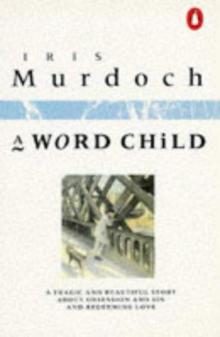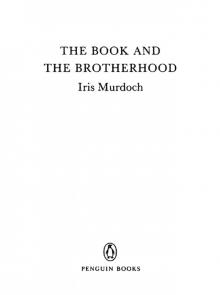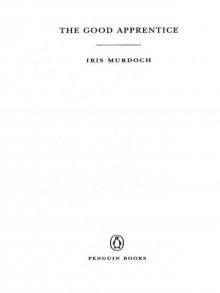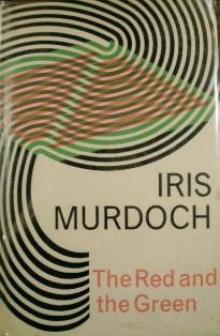- Home
- Iris Murdoch
Metaphysics as a Guide to Morals Page 2
Metaphysics as a Guide to Morals Read online
Page 2
Structuralism (as deconstruction) is a radical form of present-day demythologisation, in which the nature of the process itself is to be clarified. It seems like traditional metaphysics, a search for hidden a priori determining forms, constituting an ultimate reality. Here again the prophetic artist provides symptoms which are analysed and reinforced by the ‘philosopher’ as critic. Art, and indeed the whole of human activity, is said to consist of a matrix of linguistic (meaning-bearing) codes which are not the production of individuals, and which constitute the reality to which in the past they seemed to point. There is an old difficulty here, that of the metaphysician who describes reality but cannot include himself. Structuralist aesthetics allows a kind of special freedom to its creators and to those who understand the doctrines. The ‘language’ which constitutes reality has here an open creative fringe where poets and critics take some part in inventing new concepts. The critic as philosopher and metaphysician approaches, indeed tends to become, the artist who is making the language. The subject matter of art is then the nature of the process itself. The old conception of mimesis as reference to a transcendent reality, transformed and presented by an individual artist, is superseded. A case of the ‘old consciousness’ would be our illusion of looking through the pages of a book into another world. Reality, it is argued, lies in the linguistic medium itself, in the various (including scientific) languages of the planet, and in the meanings, inspirations, promptings, illuminations, which they can self-reflectively convey now. (Physics: the cosmos is the sum of observations of it.) We are to be sceptical of anything, including the past, which can be intuited as transcendent and somehow existing separately in its own right.
The new mood has found popular and instinctive expression in art in cults of the ephemeral or deliberately incomplete, expressive of communal feelings, not to be seen as ‘statements’. We have become familiar with minimalism, ‘happenings’, abstract paintings designed to invite ‘completion’ by provoked clients, natural objects or artefacts offered as works of art, ambiguous entities posing the question ‘Is this art?’ Theatre audiences are alienated so as to produce their own drama by participation. Writers may be led, or instinctively prefer, to produce short manifestly literary ‘texts’ instead of the old lengthy carefully constructed objects, and to offer challenging paradoxes or puzzles instead of clarifications. Even plain discursive prose may be suspect as being insufficiently stirring, too naively and soothingly referential. We may be reminded here of Wittgenstein’s Tractatus, and also of another exponent of ‘indirect communication’, Kierkegaard, who was not the only theologian to feel that discontinuity, shock and paradox represented the best way to prompt understanding of what is really deep. The paradox before which the intellect surrenders is an idea common to (some) Christian and Buddhist thinking. ‘Structuralism’, which summarises a mood of scepticism and demythologisation, is of course also a vast ragbag of interesting ideas and tendencies, some very illuminating, some far from new, if we were to regard Kierkegaard (for instance) as a proto-structuralist. His aim however was to promote faith in terms of an individual’s appreciation of a religious truth manifested in a story about a person and pointing to a transcendent reality. Here we may glimpse the extreme complexity of the whole idea of demythologisation and its challenge to conceptions of transcendence. Some modern demythologising theology is now structuralist in tone, where it used to be existentialist. Many structuralist writers are explicitly hostile to religion. Metaphysical problems now reach the popular consciousness in the form of a sense of loss, of being returned to a confused pluralistic world from which something ‘deep’ has been removed.
Art attacks art and thrives by doing so. The artist derives energy from loving, but also from hating, the art of the past. Iconoclasm can be a spiritual activity, Platonism is creative iconoclasm. Is there anything unusual or portentously extreme in current hostility to traditional ideas? Is there some clear analogy, or connection, between iconoclasm in art and the more challenging or reductionist trends in modern theology ? The violence of shock and paradox has of course always been at home in Christianity ever since Paul made his point of preaching not just Christ but Christ crucified. However, the calming whole-making tendencies of human thought have also been at work, creating reassuring structures which occasional prophets feel moved to tear down in order to rejoin the original shock. The Judaeo-Christian God owes a considerable debt to art, may even be seen as a work of art. The doctrine of the Trinity is a celestial aesthetic celebration of internal relations. Eastern art has not been so ‘thingy’ or concerned with complex completeness; and eastern philosophy and religion are more evidently mystical. The relation of eastern art to religion has been on the whole more intuitive and carefree, whereas western art has served religion and its dogmas. Our ordinary western attitudes to art in our new age of iconoclasm, and in spite of television and computers, have not yet perhaps so deeply or visibly changed. We still, in our unregenerate way, ignoring the Zeitgeist, take refuge in art. People still read novels and listen to Mozart. We still worship the artists whom we understand and enjoy, and there are few matters about which we are more uncritical and opinionated than our own aesthetic prejudices, which can combine great subjective certainty with an absence of conclusive argument. A hymn of praise in gratitude for the joys and consolations and general usefulness of art might run as follows. Art is informative and entertaining, it condenses and clarifies the world, directing attention upon particular things. This intense showing, this bearing witness, of which it is capable is detested by tyrants who always persecute or demoralise their artists. Art illuminates accident and contingency and the general muddle of life, the limitations of time and the discursive intellect, so as to enable us to survey complex or horrible things which would otherwise appal us. It creates an authoritative public human world, a treasury of past experience, it preserves the past. Art makes places and opens spaces for reflection, it is a defence against materialism and against pseudo-scientific attitudes to life. It calms and invigorates, it gives us energy by unifying, possibly by purifying, our feelings. In enjoying great art we experience a clarification and concentration and perfection of our own consciousness. Emotion and intellect are unified into a limited whole. In this sense art also creates its client; it inspires intuitions of ideal formal and symbolic unity which enable us to co-operate with the artist and to be, as we enjoy the work, artists ourselves. The art object conveys, in the most accessible and for many the only available form, the idea of a transcendent perfection. Great art inspires because it is separate, it is for nothing, it is for itself. It is an image of virtue. Its condensed, clarified, presentation enables us to look without sin upon a sinful world. It renders innocent and transforms into truthful vision our baser energies connected with power, curiosity, envy and sex.
Such a paean might now seem to many people remote, expressing an old-fashioned or romantic over-valuation of art or misunderstanding of its role. Is art really as pretentious as that, it may be argued, is it really as good as that? This enthusiasm depends upon a certain amount of discreet switching between ‘art’ and ‘great art’. In fact there is very little great art and not all that much good art. Is not an ideal morality, an unexamined idea of perfection, being improperly introduced into the background? There is an important difference between learning about virtue and practising it, and the former can indeed be a delusive substitute which effectively prevents the latter. Even great art can be a potent source of illusion, a fact which may suggest to some that we are better employed in examining the social effects of art than in uncritically celebrating its ‘spiritual’ splendour. Why did Plato not take the art object as the image of the good, as (in effect) Hegel did? And, in his earlier reflections, Wittgenstein. (Notebooks 1914 – 1916, 7.10.16. Tractatus 6. 45.) The art object, transcendent, clarified, self-contained, alone, secure and time-resistant, shedding light upon the miserable human scene, prompting compassion and just judgment, seems like a picture of goodness itself, a sort of
semi-sensory image of a spiritual ideal.
Kant did not regard art as a great moral liberator. He did however cautiously take it (the beautiful) as a symbol of morality. The work of art, not subject to an empirical concept, is produced by the free spontaneous activity of the imagination acting in accord with the notion of ‘an object in general’. It is ‘purposeful without purpose’, a ‘finality without end’. This is like the free activity of the moral will (practical reason) which ‘invents’ the moral act which, like the work of art, exists for itself, for its own sake. Aesthetic harmony is however felt not reasoned, and Kant’s system separates art from practical rationality and from the (in effect rational) ‘moral emotions’. (Respect for morality, sublime feelings about the cosmos.) Our ‘sublime’ sensations are evoked by a sense of our finitude, fear of what we cannot make sense of (in the face of nature, for instance) combined with sturdy confidence in our rational power. This in turn is like ‘respect for moral law’ (Achtung), where the pain of frustrated desire combines with pride in our free moral nature. Such experiences, characteristic of rational beings, are on a higher level than aesthetic pleasure. The confusion of the aesthetic with the moral represents a natural temptation, and Kant, like Plato, wants to keep morality ‘safe’ from art. The strictness, purity and simplicity of the concept of duty should be our refuge and prime safeguard. Kant thought that the good life was within the reach of all, but that our dual nature (the determinism of our selfishness versus the freedom of our response to reason) makes it difficult. We are to be obedient to moral law, subject to the demands of reason. Goodness is not spontaneous. We cannot attain perfect freedom or even profitably imagine it. We must be humble enough to ‘do the next thing’, eschewing attractive and grandiose speculations, taking as our immediate starting point the authoritative experience of duty, which is also our experience of freedom. In considering these different views of art and of morals we may see how deep instinctive moral intuitions find expression in large movements of abstract thought. It has been picturesquely suggested that if Newton had not been inhibited by his religious beliefs he would have discovered relativity.
As there is much to say about Plato in the pages which follow, a preliminary note is needed. Plato uses myths to explain his conception of human life. His most famous picture is that of the Cave (Republic 514) wherein people facing the wall at the back see at first shadows, then, turning round, the objects, themselves imitations of real things, which, in the light of a fire, have cast the shadows. They (we) may perhaps go no further, taking the fire to be the only source of light. Some of us may venture on, glimpsing another light beyond, and emerge into the sunlight, where we are dazzled and can only look down at shadows and reflections, then, raising our heads, see the real things themselves and then (if finally enlightened) the sun. This parable portrays a spiritual pilgrimage from appearance to reality. We turn round, we climb up, we raise our heads. At each stage we see at first the shadows of what is more real and true. Plato’s ‘Theory of Forms’ deals with logical and moral questions. The (mythical, postulated) Forms (or Ideas) are models, archetypes: universals, general concepts as distinct from particular entities, and, in their ethical role, moral ideals active in our lives, radiant icons, images of virtue. The moral Forms are interrelated. (Justice relates to Truth.) The supreme power, which unifies the Forms, is the Form of the Good, pictured in the Cave myth as the sun. Other Platonic imagery (for instance concerning the soul) should also be understood (as Plato reminds us from time to time) as hermeneutic ‘as if’. These are instructive pictures. The Theory of Forms has been a subject of endless scholarly dispute, often involving (to quote Myles Burnyeat, The Theaetetus of Plato, p. 39) ‘temperamental as well as intellectual factors’. Also, to be noted at the start, ‘A great work of philosophy demands a response which is more than merely intellectual.’ (Burnyeat, p. 37.)
At Republic 484CD Plato uses the image of the painter to set forth the notion of the good man gazing at the model (or form or image or idea) of spiritual truth (reality) in his soul and keeping his gaze steadily thereon as he sets about the business of practical life. Kant speaks in a similar way about the idea of rational law in general, the potentiality of moral freedom which is lodged in every human bosom, and which supersedes even the vision of Christ. ‘Even the Holy One of the Gospels must first be compared with our ideal of moral perfection before we can recognise Him as such.’ (Fundamental Principles of the Metaphysic of Morals p. 30, Abbott’s translation, hereinafter referred to as the Grundlegung.) Both Plato and Kant use an image of referring to an ideal or original pattern, not as imitation either of the model itself or of some chosen instantiation (example) of it, but as an inspired interpretation into the realm of practical life of a deep and certain moral insight. The notion of copying the model itself would be a ‘category mistake’, since the model is not a particular thing, like a particular command or picture; imitatio Christi does not work simply by suggesting that everyone should give away his money, or wondering how Christ would vote. The Demiurge (mythical creator) in Plato’s Timaeus, ‘copying’ the Forms (spiritual Ideas) in order to create the world, interprets them into an entirely different medium. A difference between Kant and Plato is that Plato insists that approach to the central Idea (pure goodness, the Form of the Good) comes through a difficult disciplined purification of intellect and passion, wherein passion (Eros) becomes a spiritual force. Whereas Kant regards ‘feelings’ as dangerous to morality, sharply divides (noumenal) reason from (phenomenal) emotion, and stresses that dutiful action is something of which every man is immediately capable.
Plato’s use of the painting metaphor is not in fact intended as a kind word to painters, who are taken in book X of the Republic as a prime case, and indeed image, of the bad effect of art. Painting is often thus used as an image of the other arts. The painter looking at his subject, say, a bed, to use Plato’s example, is not like the virtuous man who looks toward an idea of goodness. As Plato explains (Republic 597), the painter is ‘three removes from reality’. ‘God’ creates the single ideal noumenal idea of the bed, the carpenter makes instances of ‘real’ (phenomenal) beds, the painter copies a mere appearance of one of these, without understanding, without, for instance, knowing how beds are made. Plato’s use of ‘God’, theos, here is picturesque. So the carpenter is nearer to heaven than the painter since he has at least obtained at a simple level some mathematical ideas, some exercise of reason which enables him in a disciplined way to distinguish true and false, apparent and real. Skills such as measuring, weighing and using numbers are described (602D) as ‘benign assistants’ to the truth-seeking mind. Later in Book X (605A) the case of the painter is used to introduce that of the poet, who, even if he be as great as Homer or the tragedians, is still a charming illusionist, a kind of sophist. Imitation is a sort of play. The character of the sophist, as portrayed in the dialogue of that name, is very like that of the artist in Republic X. The poet can only present virtue in an imitative way, and does not really understand it (600E), just as the painter does not really understand the bed. Moreover the practice of such imitation inhibits the artist and his client from the effort of penetrating beyond appearances. Plato speaks of an ‘old quarrel between poetry and philosophy’ (607B). (A quarrel, as I suggest later, which is continuing today.) Literature is even more dangerous than painting since it delights in presenting bad men as interesting and attractive. Such men are easier to portray than good men since the former are always agitated and changeable, whereas the latter are monotonous and steady (604E). Goodness, being lucid and quiet and calm, cannot be expressed or represented in art. Writers, not exceptional for virtue, understand and sympathise with mediocrity and egoism, and cannot perceive goodness. The good are mocked. Art deals with what is peevish and mutable and unstable in human nature since this is easily imitated and grasped, and is more amusing. (Plato is now speaking of literature. He takes it for granted that a painting is less real than what it represents.) Art is the base addressing the b
ase. It is motivated by and caters for the lowest part of the soul, the bad unconscious, which is to be contrasted with anamnesis, the good unconscious. The client is thus encouraged to ‘take over’ the work as his own fantasy. Art fascinates us by exploring the meaner, more peculiar aspects of our being, in comparison with which goodness seems dull. (Artists are indeed unlikely to be good, goodness would silence them.) Good art can corrupt us (Plato is speaking of Homer and the tragic poets), and the good man is as much at risk as the bad man. In sympathising with a fictional character we abandon ourselves to emotional excesses which weaken our better nature. By unreflective imitation literature stirs up our feelings so that the higher part of our soul ‘relaxes its guard’ (606A) over self-indulgent emotion, and we become lazy sentimental spectators of fictional dramas, abandoning the stoical restraints and standards which we exercise in ordinary life. We may find satisfaction in viewing the misfortunes of others. (Every day on television!) Such experiences, for instance in the theatre, are not, as Aristotle later suggested, a purgation of our emotions by pity and fear, but rather a fostering of base impulses of sex and anger and selfish desire which ought to be induced to dry up and perish (606D). Poets then encourage what is irrational and undiscriminating in the human soul (605C). Here comedy which, regardless of merit, derides what is unsuccessful or ill-favoured, is as bad as tragedy. Plato objects to Homer’s description of the gods laughing in the first book of the Iliad (I 599); and at Laws 656B he describes how a decent man can come to tolerate and be amused by, and only casually to criticise, the base habits of those among whom he lives. Jokes are an art form, and witticisms in private conversation can corrupt. We tolerate clowning and buffoonery and cruel wit, when it comes to us in the guise of art, which we would not accept as any real part of our own conduct. In many areas of ordinary life, art makes a fascination with what is mean and trivial seem innocuous. Art is most pernicious when it poses as a spiritual achievement and inhibits serious reflection and self-criticism. Enjoyment of art is soothing, and may persuade us that we ‘understand’ (life, people, morality) and need make no further efforts. The great artists especially make us feel that we have arrived; we are home. We feel that we are already wise and good. Plato qualifies his spirited tirade by a mitigating gesture. ‘However if sweet poetry and mimesis can show reason why they should exist in a well-governed state we will gladly let them in; for we ourselves are very conscious of their charm.’ (607C.) His general conclusion remains that art is both politically and spiritually dangerous; the only good mimetic artist is the Timaeus Demiurge.

 Jackson's Dilemma
Jackson's Dilemma The Flight From the Enchanter
The Flight From the Enchanter The Red and the Green (Vintage Classics)
The Red and the Green (Vintage Classics) A Severed Head
A Severed Head The Black Prince
The Black Prince The Nice and the Good
The Nice and the Good The Unicorn
The Unicorn Under the Net
Under the Net The Italian Girl
The Italian Girl A Fairly Honourable Defeat
A Fairly Honourable Defeat An Accidental Man
An Accidental Man A Word Child
A Word Child The Philosopher's Pupil
The Philosopher's Pupil The Book and the Brotherhood
The Book and the Brotherhood The Good Apprentice
The Good Apprentice The Sacred and Profane Love Machine
The Sacred and Profane Love Machine The Bell
The Bell Henry and Cato
Henry and Cato Metaphysics as a Guide to Morals
Metaphysics as a Guide to Morals The Time of the Angels
The Time of the Angels Nuns and Soldiers
Nuns and Soldiers The Green Knight
The Green Knight The Sea, the Sea
The Sea, the Sea Sartre: Romantic Rationalist
Sartre: Romantic Rationalist Bruno's Dream
Bruno's Dream An Unofficial rose
An Unofficial rose Sartre
Sartre The Red and The Green
The Red and The Green